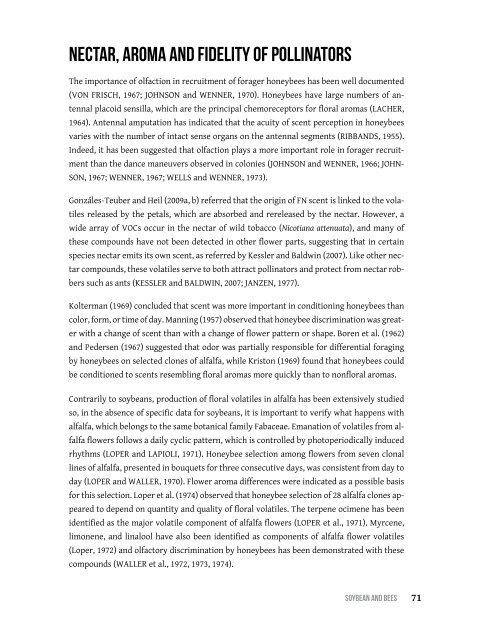Soybean and Bees
You also want an ePaper? Increase the reach of your titles
YUMPU automatically turns print PDFs into web optimized ePapers that Google loves.
Nectar, aroma <strong>and</strong> fidelity of pollinators<br />
The importance of olfaction in recruitment of forager honeybees has been well documented<br />
(Von Frisch, 1967; Johnson <strong>and</strong> Wenner, 1970). Honeybees have large numbers of antennal<br />
placoid sensilla, which are the principal chemoreceptors for floral aromas (Lacher,<br />
1964). Antennal amputation has indicated that the acuity of scent perception in honeybees<br />
varies with the number of intact sense organs on the antennal segments (Ribb<strong>and</strong>s, 1955).<br />
Indeed, it has been suggested that olfaction plays a more important role in forager recruitment<br />
than the dance maneuvers observed in colonies (Johnson <strong>and</strong> Wenner, 1966; Johnson,<br />
1967; Wenner, 1967; Wells <strong>and</strong> Wenner, 1973).<br />
Gonzáles-Teuber <strong>and</strong> Heil (2009a, b) referred that the origin of FN scent is linked to the volatiles<br />
released by the petals, which are absorbed <strong>and</strong> rereleased by the nectar. However, a<br />
wide array of VOCs occur in the nectar of wild tobacco (Nicotiana attenuata), <strong>and</strong> many of<br />
these compounds have not been detected in other flower parts, suggesting that in certain<br />
species nectar emits its own scent, as referred by Kessler <strong>and</strong> Baldwin (2007). Like other nectar<br />
compounds, these volatiles serve to both attract pollinators <strong>and</strong> protect from nectar robbers<br />
such as ants (Kessler <strong>and</strong> Baldwin, 2007; Janzen, 1977).<br />
Kolterman (1969) concluded that scent was more important in conditioning honeybees than<br />
color, form, or time of day. Manning (1957) observed that honeybee discrimination was greater<br />
with a change of scent than with a change of flower pattern or shape. Boren et al. (1962)<br />
<strong>and</strong> Pedersen (1967) suggested that odor was partially responsible for differential foraging<br />
by honeybees on selected clones of alfalfa, while Kriston (1969) found that honeybees could<br />
be conditioned to scents resembling floral aromas more quickly than to nonfloral aromas.<br />
Contrarily to soybeans, production of floral volatiles in alfalfa has been extensively studied<br />
so, in the absence of specific data for soybeans, it is important to verify what happens with<br />
alfalfa, which belongs to the same botanical family Fabaceae. Emanation of volatiles from alfalfa<br />
flowers follows a daily cyclic pattern, which is controlled by photoperiodically induced<br />
rhythms (Loper <strong>and</strong> Lapioli, 1971). Honeybee selection among flowers from seven clonal<br />
lines of alfalfa, presented in bouquets for three consecutive days, was consistent from day to<br />
day (Loper <strong>and</strong> Waller, 1970). Flower aroma differences were indicated as a possible basis<br />
for this selection. Loper et al. (1974) observed that honeybee selection of 28 alfalfa clones appeared<br />
to depend on quantity <strong>and</strong> quality of floral volatiles. The terpene ocimene has been<br />
identified as the major volatile component of alfalfa flowers (Loper et al., 1971). Myrcene,<br />
limonene, <strong>and</strong> linalool have also been identified as components of alfalfa flower volatiles<br />
(Loper, 1972) <strong>and</strong> olfactory discrimination by honeybees has been demonstrated with these<br />
compounds (Waller et al., 1972, 1973, 1974).<br />
SoybeAn <strong>and</strong> bees<br />
71


